Get weekly tips, recipes, and my Herbal Jumpstart e-course! Sign up for free today.

Weeds You Can Eat
Share this! |
|
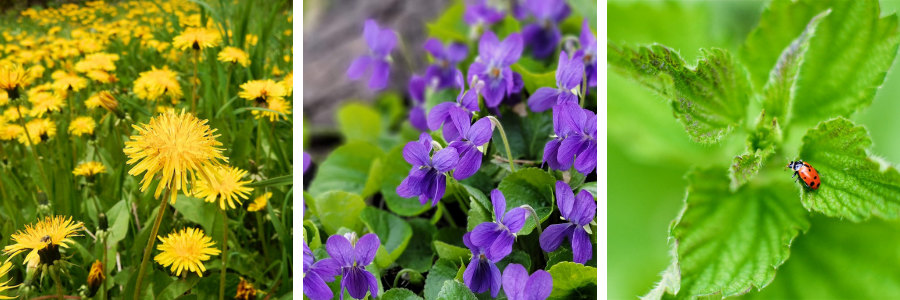
When it comes to the weeds you can eat, there’s a whole feast of spring greens waiting just outside your door!
Wouldn’t it be nice to have trustworthy information so you can:
► Be 100% sure you identify edible weeds correctly (and avoid any poisonous look-alikes)
► Gather in a way that ensures plenty of future harvests
► Enjoy yummy (and good for you) recipes with loved ones
By the end of this episode, that’s knowledge you’ll have for three common weeds you can eat.
You’ll also receive instant access to a free chapter from my book, Wild Remedies: How To Forage Healing Foods and Craft Your Own Herbal Medicine, containing three fun and easy-to-make spring greens recipes.
-- TIMESTAMPS --
- 00:00 - Introduction to Weeds You Can Eat
- 03:09 - Wildcrafting Safety First
- 08:34 - Dandelion benefits (Taraxacum officinale)
- 09:37 - Dandelion identification and look-alikes
- 12:31 - How to harvest dandelions
- 14:27 - Stinging Nettle benefits (Urtica dioica)
- 16:25 - Nettle identification and look-alikes
- 18:23 - How to harvest stinging nettle
- 20:12 - Violet benefits (Viola spp.)
- 23:11 - Violet identification and look-alikes
- 24:45 - How to harvest violets
- 25:59 - Closing comments and additional resources
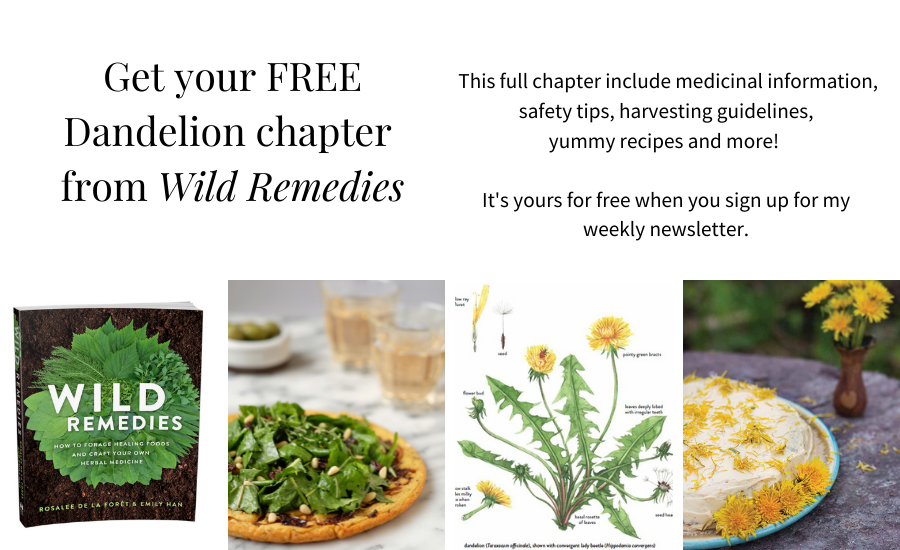
Transcript of the Weeds You Can Eat Video
As new plant growth emerges in the spring, I am excited to grab my basket and harvest weeds you can eat. When it comes to edible weeds there’s a whole feast of spring greens waiting just outside your door!
I’m going to show you how to safely identify and harvest weeds you can eat and make delicious spring greens recipes. This will be helpful for you if you are harvesting from your garden or from more feral places like forests, meadows, and parks.
Harvesting weeds you can eat can be fun and empowering. Knowing how to look at a landscape, identify the edible weeds as food and then harvest them safely are skills everyone should have.
When I harvested edible weeds for the first time, one thing really stuck out in my mind. FREE FOOD. I was in my young twenties, I didn’t have a lot of money, and I was absolutely amazed at all the free edible weeds growing around me!
Over time, however, I realized that weeds you can eat aren't actually free. They take both time and energy. As I spent more and more time with edible weeds, I also learned that the coolest part wasn’t the “free” aspect. Instead, being outside, interacting with the plants and giving back to the plants were the ultimate gift.
So instead of simply plopping “free” food on the table, I was actively participating in the world around me and bringing deeper connections and meaning to my spring greens meals. This mindset switch from free weeds you can eat to a deeper connection with the food I eat has ultimately given me a richer life.
I’ll bet many of you have experienced the same thing!
While you’re watching, let me know in the comments below about your experience with weeds you can eat and spring greens recipes. It’s always interesting and insightful to hear the experiences of plant lovers out there. Your suggestion may also help others!
Okay, let’s dive in.
Wildcrafting Safety for Weeds You Can Eat
Harvesting weeds you can eat isn’t hard! But you really have to know what you’re doing in order to stay safe, to avoid causing damage both to yourself and the living world where you’re harvesting. There’s also important tips to make the whole process easy and fun.
One of the most important safety aspects of harvesting weeds you can eat is to evaluate if you have enough time. Especially when you are harvesting a plant for the first time, you don’t want to be rushed.
You need time to identify the plant properly.
Time to assess the area you are harvesting.
Time to actually harvest, and, just as importantly, time to clean and prepare your spring greens recipes.
Obviously you are already investing time by reading this article! So well, done.
Knowing how to properly identify the plant you are harvesting can mean the difference between life and death. You not only want to know how to identify the particular edible weed you want, but also to know their common look-alikes.
You never want to be “mostly” sure about identification. You want to be 100% sure. I am going to show you key identifying features for all of the weeds you can eat that I’m sharing about today.
Another really important, and often overlooked part of harvesting weeds you can eat, is respect. I doubt you would like it if someone walked into your space, made a mess, and started filling their bags with your stuff. Sometimes edible weeds don’t get as much respect or admiration as native wild plants, but I think that’s flat out wrong. Part of respect is making sure you have permission to gather from that location.
When we go to gather weeds you can eat we are entering a space that many beings call home. Whether it’s the plants themselves, the insects and bugs that feast and find shelter there, the vast mycorrhizal networks beneath our feet, the birds that also forage and nest there, the mammals that frequent there, including other humans, and so on. From the moment you intend to gather weeds you can eat to sitting down to your spring greens meal, I promise you’ll get the most out of the whole experience if you respect all the beings that we share these spaces with.
Another aspect of safety is knowing how to assess if the area is safe to harvest from. Many weeds you can eat are great at phytoremediation or cleaning up the soils. They can pull toxins from the soils and then store them in their aerial parts. The only way to be absolutely certain if the soils are safe is to do a soil test. However, this can be a bit of a hurdle, especially if you harvest in multiple areas.
You can also know a lot about the soils by knowing the history of those lands. Cautions to look out for include areas near train tracks, golf courses, roadsides, mines, or any other situation where pollutants may have been spilled in the area. I would also avoid places highly frequented by dogs.
A basic question to ask when harvesting in an area is do these plants look healthy and vibrant? The better you know the lands you are harvesting from the more you can ensure it’s safe to harvest there.
The last consideration I want to highlight is the importance of ensuring that the areas where you harvest continue to thrive. This is important for future harvests, but also simply for respect and decency. I doubt many people’s intentions are to wipe out plant populations or decimate an area… but sadly this happens either out of naive ignorance or they are simply jerks who think they have a right to take all that they see. Not cool!
Ways you can make sure the area you harvest continues to thrive is by knowing what’s an appropriate amount to harvest, how to harvest so the plants continue to grow, and by stewarding or caregiving the area by filling in harvesting holes, picking up trash, etc.
Okay, we’ve just covered a lot of things to consider about the harvest! I’m going to stop there for now, but there is a lot more to know!
If you are feeling the itch to really dive into harvesting edible weeds then you’ll love my book,
Wild Remedies: How to Forage Healing Foods and Craft Herbal Medicine. This book shows you everything you need to know to feel confident about harvesting edible weeds that grow around you.
The beginning chapters show you the exact skills needed to harvest safely.
And then each plant chapter gives specific information about that plant's benefits and gifts, how to grow and harvest the plant sustainably, and many recipes for food and medicine.
There are also beautiful botanical illustrations to help you correctly identify the plant.
You can find Wild Remedies wherever books are sold. Once you buy the book don’t miss out on your exclusive bonuses. Click here for more information.
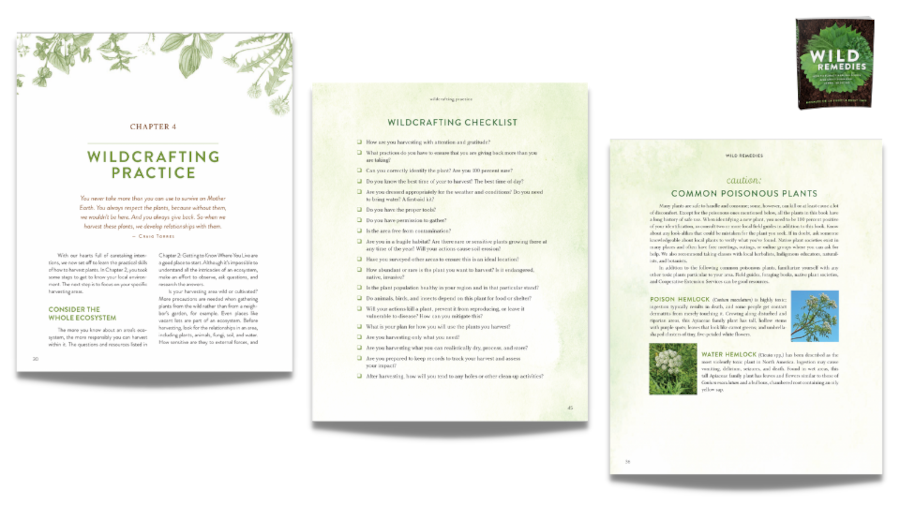
Okay, let’s look at our common weeds you can eat.
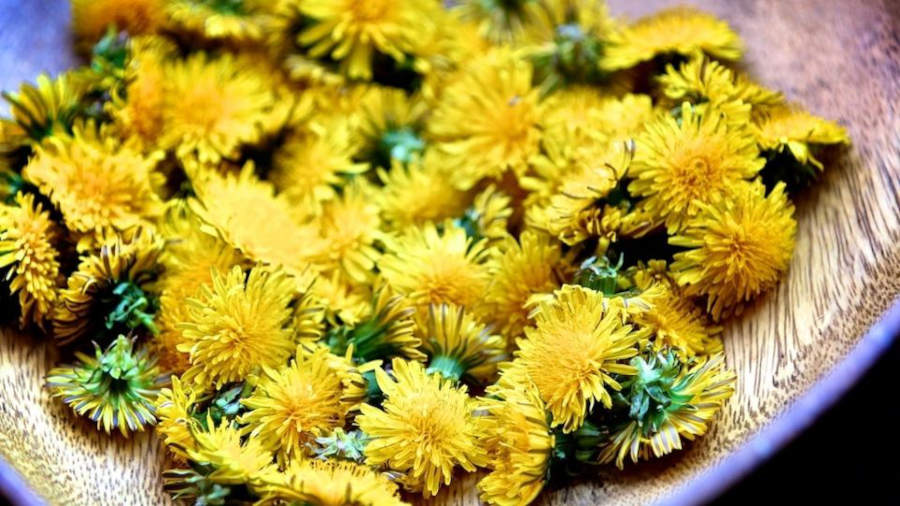
Weeds You Can Eat: Can You Eat Dandelion (Taraxacum officinale)?
Dandelions tell us that spring is here! Often among the first 'weeds you can eat' to emerge, especially in northern climates, dandelions bring important early nectar to honeybees and lift the hearts of all who anticipate longer days and warmer temperatures.
These golden orbs fill lawns and meadows and even appear between the cracks in concrete. Dandelion is both tenacious and generous and is one of our most-needed plant foods and medicines.
I love how generous dandelions are! Every part of this plant offers us food and medicine. It is totally incomprehensible to me that people pour billions of pounds of herbicides on these beautiful and generous plants every year. Those chemicals then pollute our lawns, soils, and our waters. It’s total madness!
Dandelion is the edible weed that I wish everyone would fall in love with. Then, instead of poisoning the earth with chemicals, people could be harvesting the plant for spring greens.
Dandelions are common and well known, but there are some very similar-looking plants with yellow flowers that can be easily mistaken for dandelion. It’s important to know how to identify dandelion well.
Let’s start with the leaves.
Dandelion leaves grow from a central point and can be anywhere from 2-14 inches long. They often have a toothed appearance. The leaves are smooth, not hairy. If you are looking at a similarly-shaped leaf but it has a prickly spine or is hairy, then you know it’s not dandelion.
The flowers are vibrantly yellow. Each flower grows from a single stem which is a hollow stalk. That’s an important distinction because some lookalikes have multiple flowers growing from one stem.
What looks like a single flower is actually hundreds of individual flowers. We refer to this as a composite flower.
At the bottom of each flower there are pointy green bracts. These bracts often have a bitter flavor and so they are typically removed when preparing the flowers as food.
When you’re learning how to recognize dandelion it’s helpful to be familiar with common look-alike plants, which include cat’s ear, hawkweed, sow thistle, chicory , and young wild lettuce.
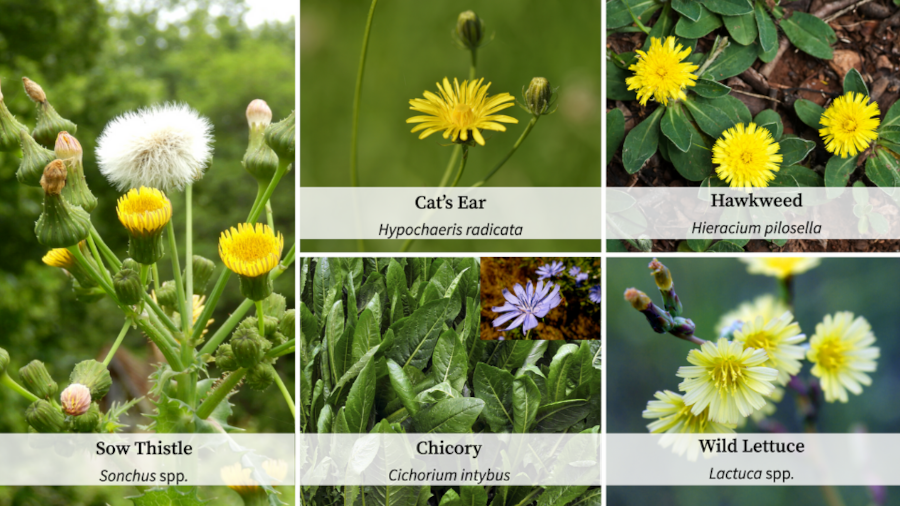
Many beings rely on dandelion for food, ranging from small insects to mammals, including rabbits, groundhogs, pocket gophers, deer, elk, and even bears. The flowers provide nectar and pollen to insects such as honeybees, native bees, bee flies, and hoverflies. After the blooms have gone, small birds are known to eat the seeds.
Every part of the dandelion plant can be harvested, but in this episode I’ll focus on the leaves and flowers.
When
dandelion leaves are young and tender, they have a slightly bitter
taste. This stimulates many digestive functions and secretions, including
increased saliva (which helps to break down starches and
carbohydrates), increased stomach enzymes (that further break down
starches and proteins), increased bile (which aids fat digestion), and
stimulates natural peristalsis (to keep the bowels moving).
For this reason the leaves are considered a spring greens tonic, something that is taken to enliven digestion after a winter of heavy meats and stored vegetables.
Dandelion flowers are both food and medicine. As a food, they have a sweet, bland taste and are high in nutrients like lutein and beta-carotene, both known for the ability to support eye health.
In addition to vitamins and minerals, dandelion flowers are high in flavonoids.
Leaves
and flowers can be gathered by hand or with scissors throughout the
growing season. The leaves are best when young, as they become more
bitter and tough as they age. There’s no set rule as to when they are
tasty and when they’re not. Look for visibly young leaves then nibble
some to let your taste buds decide. The leaves can be eaten raw or
cooked. I love them in salads or slightly wilted in warm wraps.
Dandelion
flowers tend to bloom big in the spring and then sporadically after.
Flowers and buds can be used whenever they’re available.
Something
to note is that the flowers will readily go to seed after you harvest
them, so it’s best to gather them and then use them immediately. When
harvesting flowers, keep in mind that they provide early spring food for
bees and other insects. So leave some behind for others.
Also,
harvest safely! Every year billions of dollars are spent on herbicides
attempting to eradicate the dandelion. Harvest dandelions in an area
that hasn’t been poisoned for at least three years and is free of heavy
metals.
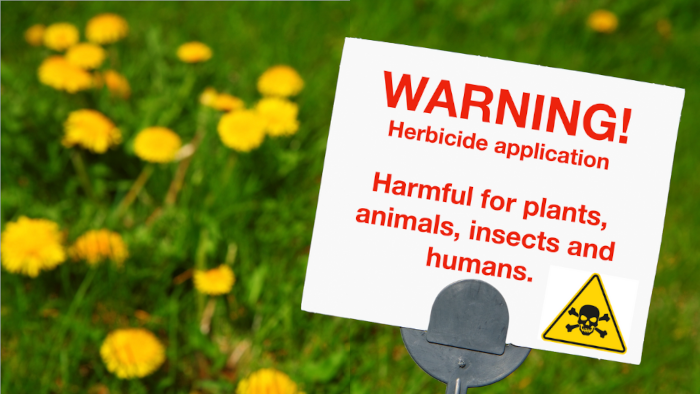
If you’d like to know more about the medicinal and edible gifts of dandelion flowers and leaves then I’ve got two resources for you.
First is a video and podcast by me that is all about dandelion.
The second is a free chapter about Dandelion from my book, Wild Remedies. This excerpt also includes recipes like Fermented Dandelion Buds and Radishes, Socca with Dandelion Greens, and, my personal favorite, Dandelion and Maple Syrup Cake. Get it by signing up for my newsletter below!

Our next of the weeds you can eat is the beautiful…
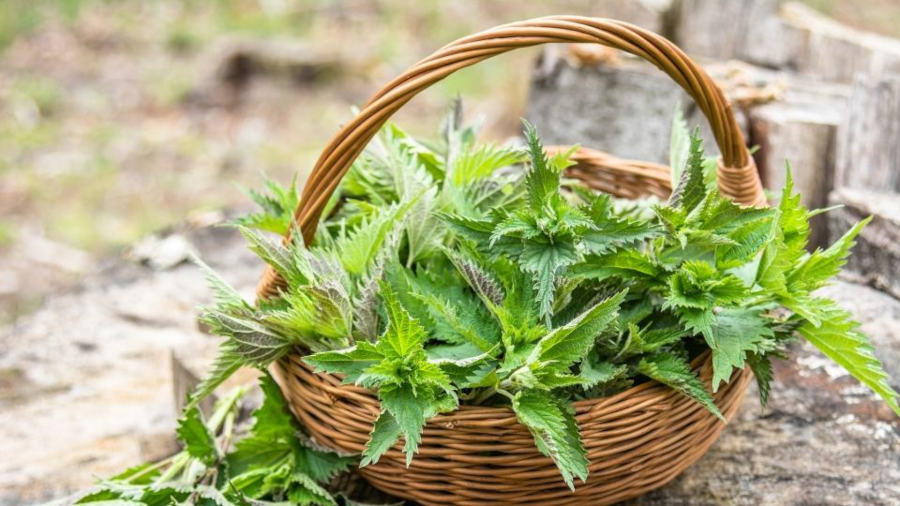
Weeds You Can Eat: Stinging Nettles (Urtica dioica)
Stinging nettles demand your attention! And not just because they sting! But also because they offer so many powerful health benefits.
Stinging nettles are a highly nourishing food. If you’re feeling run down, depleted, or otherwise dragging yourself throughout the day, then turn to nettles leaves as they can support naturally healthy energy levels. It may do this through a variety of actions, but at least part of that action comes from its nutrient-dense qualities.
Nettle leaves are high in nutrients, including calcium, fiber, protein, potassium, flavonoids like rutin, ascorbic acid, glucosamine, beta- carotene, vitamin K, and many more. Few plants boast the nutrient content of nettle, and few plants have benefits as dramatic when enjoyed frequently. Eating nettle or drinking its strong tea regularly often results in healthier bones, stronger teeth, and more vibrant hair.
Nettle infusions are also a reliable way to boost iron levels. I’ve spoken to many women who have chosen to use nettle instead of iron supplements in the early stages of pregnancy to increase their iron levels. And restoring iron levels can also relieve fatigue.
Some people experience muscle cramping due to nutrient deficiencies. Regular ingestion of nettle infusions can restore mineral reserves and relieve menstrual cramps or leg cramps.
A study done in April of 2021 showed that adding nettles to bread significantly increased the nutrient content, including fiber, calcium, copper, and iron.1 The nettle-enhanced bread also had superior antioxidant qualities. No surprise there! Nettles are amazing!
They are also easy to find and harvest in many places.
Nettles are easy to identify once you get to know them but there are some common look-alikes, so it’s important to pay attention to the details.
Nettle is an herbaceous perennial that can grow to about 3-6 feet in height (1-2 meters). It is both a native and introduced plant in North America and likes to grow in disturbed soils that are protein rich. It prefers damp soils.
It grows on long stalks that have a square stem with jagged simple leaves that grow opposite. Leaves growing opposite are a key identifying feature of nettles.
Small needle-like projections cover the stalk and leaves of most species (however “stingless” nettles do exist, even within the U. dioica species.)
Small flowers grow in the leaf axils in the summer, which turn to green fruits by the late summer. Both male and female flowers grow on a single plant in the Urtica dioica species.
It is not recommended to eat nettle leaves after the plant has gone to flower/seed. There’s some concerns that the plant may irritate the kidneys or even digestion at this stage. However, once they’ve gone to seed, those leaves are also lacking vibrancy. So it’s definitely best to harvest them when young.
Because nettles can concentrate heavy metals and inorganic nitrates, pay extra attention to your harvesting areas. Look-alike plants include wood nettle (Laportea canadensis), which is edible; false nettle (Boehmeria cylindrica); and clearweed (Pilea pumila).
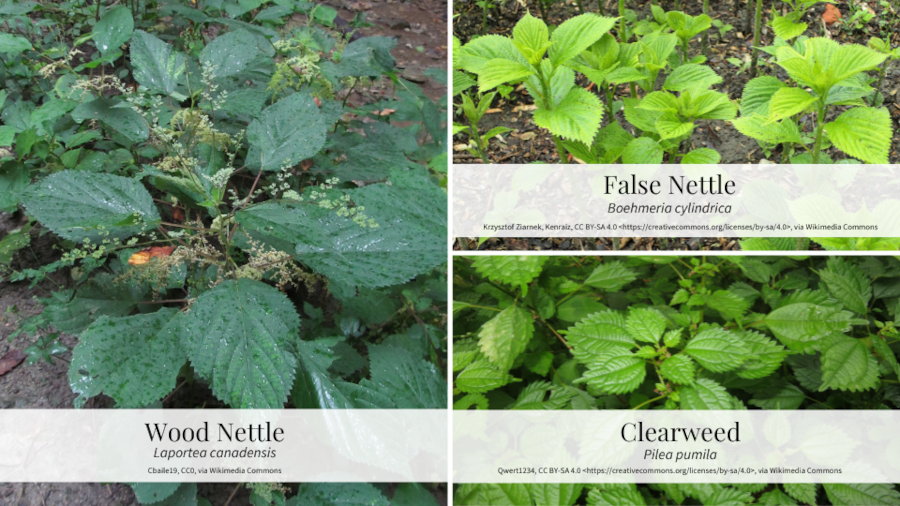
To avoid getting stung when harvesting nettles, wear gloves and even long sleeve shirts.
Speaking of getting stung, some of you may be wondering why would you want to eat something that stings you?
Stinging nettle can be eaten freely as food but it needs to be properly prepared, more about that in just a bit.
Here’s a major tip for harvesting nettles.
Harvest
the top portion of the plant, cutting the stem just above the leaf
axil. When you harvest like this the plant is stimulated to grow back,
often even more densely. In cooler climates, it’s possible to tend a
nettle patch and keep harvesting the leaves well into summer. It’s best
to harvest the leaves and put them loosely into a basket. You don’t want
to bruise the leaves.
Okay, here’s how you get rid of the sting.
Once harvested, blanch the leaves in boiling water for two minutes. This removes the sting. Easy peasy!
After
that you can use them as you would any cooked green. Some of my
favorite ways to eat nettle include: Nettle soup, lasagna, stir-fried
greens, spanakopita, green smoothies, and pesto.
Also, here’s a tip: Save the residual blanched water to drink as a tea or as a base for soups. Or feed the cooled water to your house plants, they love it too!
I love stinging nettles! That’s why this plant is featured in both of my books, Alchemy of Herbs and Wild Remedies.
Both
books have a different collection of my favorite nettle recipes,
including Stinging nettle lasagna, nettle leaf dukkha, Stinging Nettle
and Asparagus Soup, and a Nettle Frittata.
I
also have a video and podcast about Stinging Nettle Benefits and Side
Effects and a video and podcast about Stinging Nettle Tea.
This is a powerful edible weed that deserves a place in your spring greens recipes.
Our next of the weeds you can eat is the beautiful…
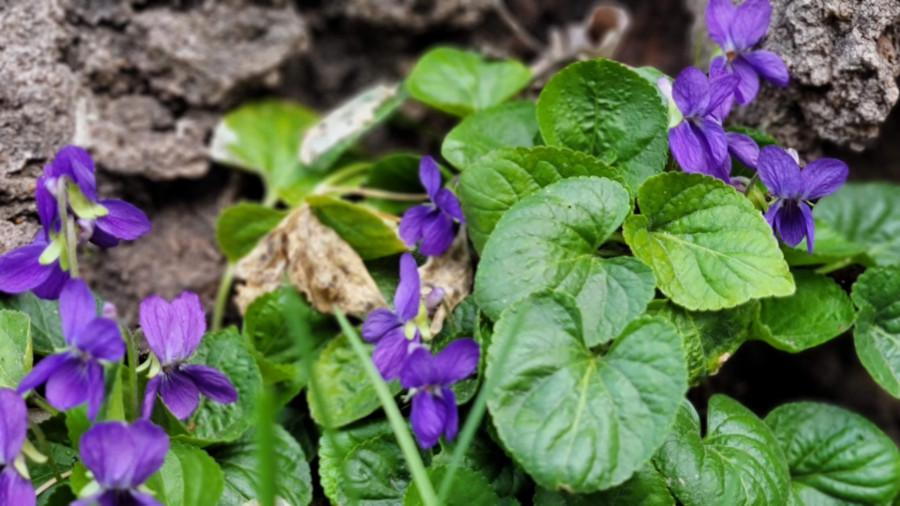
Weeds You Can Eat: Violet (Viola spp.)
One of my favorite springtime activities is wildcrafting edible violets. With the sun on my skin, the birds singing around me, and that alluring scent of Viola odorata permeating the air, it’s a joyful experience that only spring can offer.
Violet flowers and leaves offer us both medicine and food. I am focusing mainly on food for this episode but I do have a previous video and podcast on violets that shares more of their medicinal benefits.
The flowers and leaves contain high amounts of vitamin C and the leaves are also high in beta-carotenes which are precursors to vitamin A.
Violet is high in antioxidant anthocyanins and rutin, which are known to support heart health by strengthening and increasing flexibility in blood vessels, reducing cholesterol, and preventing and dissolving blood clots.
Energetically, violets are cooling and moistening; they can bring relief to hot, dry tissues and modulate inflammation.
I love working with the flowers to make beautiful syrups and garnishes which can be used in foods and beverages alike.
The leaves can be eaten raw or cooked when young. However, it’s a good idea to eat just a little at first to see how your tummy reacts. Both the flowers and leaves make a wonderful tea.
Violets are found throughout the world, though they mostly occur in temperate climates. They love to grow in damp shady places. Weedy varieties will delightfully grow abundantly in lawns.
Violets typically flower generously in the springtime, making that the easiest time to find them. Where I live, violets start to bloom around the same time as dandelions. But you can find their leaves persisting throughout the growing season. The leaves by themselves can be easily mistaken for other plants. Following the plant for a year to see how it looks throughout the seasons is always a good idea.
If you aren’t sure where violet may be growing near you, ask around! You may be surprised to find a neighbor or friend who has an abundant amount.
You can also consider growing violets, although they are hard to grow from seed and so it’s best to transplant them. For the past several years, I’ve been planting violet starts all over my yard in the hopes of having lots of flowers one day!
There are lots of kinds of violets out there. Up to 600 different species!
There also are many modern cultivars used in gardens (often called pansies or Johnny Jump Ups).
While many species are indeed purple, as the name violet implies, the flowers of the Viola genus range from white to yellow to blue and purple. They can also be multicolored.
Many violets are used similarly, but Viola odorata is one of the few violets that have that beautiful and compelling scent.
Violets have irregular flowers with five separate petals arranged in bilateral (side-to-side) symmetry. Sometimes the flowers are described as having four petals in the shape of an X and then the fifth petal is at the bottom like a tongue sticking out. Viola odorata flowers are a deep purple color.
They have five sepals which can persist after the flower has bloomed. Each flower is on a leafless stalk.
In some violet species, the showy flowers of the spring are actually sterile and don’t help the plant to reproduce.
Later in the season, cleistogamous flowers, which are closed, self-pollinated flowers, form seeds beneath the leaves. Both types of flowers result in a three-pronged seed head, which can open with incredible force, ejecting the seeds meters away from the original plant.
The simple leaves are either alternate or basal, and are often heart shaped with rounded teeth along the edges which are called crenate margins.
While violet flowers are easy to recognize, violet leaves have many look-alikes, some of them quite toxic, including monkshood (Aconitum spp.) and lesser celandine (Ficaria verna). Always be certain you can identify the plant before harvesting. I recommend getting a local plant field guide to help you identify the specific violets that are growing near you.
I’m often asked if the African violets that are commonly grown as houseplants can be used the same way as violets and the answer is no, this is an entirely different plant that is not safe to eat.
Violets are easy to harvest using only your fingers. The flowers and leaves can easily be pinched off, just take care not to disturb the roots.
You can harvest violet leaves throughout the growing season, but the spring leaves will be the most tender and best for eating. Leaves later in the season are best for drying for tea.
Native violets are much more sensitive to being over foraged. They can also be tricky to determine how strong their populations are. Violets tend to grow in isolated patches. So you may find a big patch of wild violets but it may be the only patch for miles. Unless you’re deeply connected to the land you’re harvesting from and know for certain that your harvest won’t negatively impact native violets, then I would stick with the weedy varieties.
To learn more about sustainable and regenerative harvesting check out my second book, Wild Remedies: How to Forage Healing Foods and Craft Your Own Herbal Medicine. In there we also have an entire chapter about violets and recipes including Violet Vinegar, Violet Oxymel, two violet cocktails, and a spring flowers massage oil with both violet and dandelion flowers.
Summary of Weeds You Can Eat
Well, there you have it. Three weeds you can eat for you to harvest. These three plants are some of my very favorites for spring greens recipes.
As an herbal teacher I am happiest when you’re successful with plants, whether that is foraging weeds you can eat, making herbal medicines, or strengthening your connection to nature.
Citations for Weeds You Can Eat
Click to show/hide.

Rosalee is an herbalist and author of the bestselling book Alchemy of Herbs: Transform Everyday Ingredients Into Foods & Remedies That Healand co-author of the bestselling book Wild Remedies: How to Forage Healing Foods and Craft Your Own Herbal Medicine. She's a registered herbalist with the American Herbalist Guild and has taught thousands of students through her online courses. Read about how Rosalee went from having a terminal illness to being a bestselling author in her full story here.